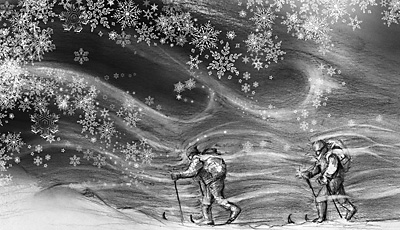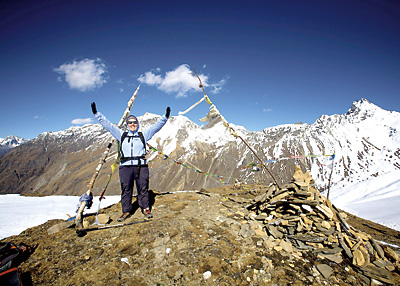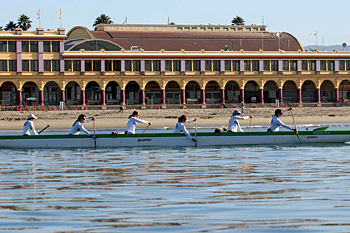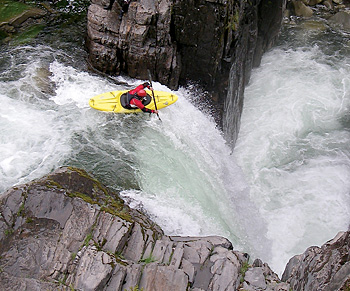 Crossing Tioga, 1932
Crossing Tioga, 1932
by Dennis Jones, California’s first ski instructor, and “Miss” Milana Jank, a German alpinist and ski ambassado
By Dennis Jones (circa late 1950s) • Illustrations by Tom Rassuchine, www.tomrdesigns.com
Editor’s Note: This account, previously never published, was written by Dennis Jones in the late 1950s, and is provided courtesy of Starr Walton Hurley, niece of Dennis Jones, and Norm Sayler, president of the Donner Summit Historical Society. The story below contains some added detail from that was merged into the story from another typed retelling of the adventure that Jones wrote some time later.
Tioga Pass, 9,941 feet high, on the backbone of the mighty Sierra Nevada, has always been considered impassable in the winter, usually closing in early fall and often not being re-opened until July. This mountainous area is one of the most rugged in the entire Unites States. A great many of the peaks rise a vertical six or seven thousand feet to a lofty 11,000 feet or more. Storms are not predicted, but just arrive. However, a crossing was made in 1932 – on skis – which had never been attempted before and which has not been accomplished since.
Miss Milana Jank, one of Europe’s foremost skiers at that time, was in the United States sponsored by her native Germany as a good will ambassador of skiing. She had crossed the Alps alone, a feat requiring 147 days; the Dolomites of Italy; the Carpathians of Russia and the Black Mountains of Serbia. In any winter exploration, her experience and physical condition would require the utmost from any person, regardless of sex. After studying maps of all snow areas in the western part of the United States, she believed Tioga Pass would present the greatest challenge.
My father had a winter resort (the Soda Springs Hotel and Ski Resort) on Highway 40 near Donner Summit in California. I had spent my winters skiing there and had crossed the Sierra many times. Ski towns were non-existent. A few trips had been through Squaw Valley, then isolated, but now to be the site of the 1960 Winter Olympics.
Knowing of these experiences and after watching me in a cross-country race at Lake Tahoe, Miss Jank came to see me at Soda Springs. Believing me to be stronger than smart, she showed me some maps outlining a possible way that we might make a crossing of Tioga Pass. It wasn’t very smart, but we decided that it was a thing we had to do, not even giving a thought that we might fail.
To gain confidence in each other, we made several crossings of the Sierra to Tahoe. I was soon convinced that if I were to try the crossing, she certainly would be my choice of a companion. She changed my opinion that a woman’s place was definitely only in the home.
We put together packs consisting of what we considered the bare essentials, but still weighing approximately 35 pounds each. At that time, very little had been done toward developing lightweight clothing, etc., for winter use. I guess the people thought it more prudent to stay around the stove than to have snow dropping off limbs down the back of their necks.
Our start was to be Bridgeport, the terminus of winter travel. We left Soda Springs by car with the hopes of driving as far as Bridgeport, but were stopped by snow on the road near Topaz Lake in Nevada. From this point on to Yosemite Valley as all skiing.
My brother (Virgil Jones), who was driving, had to back the car up for nearly two miles in the single broken tracks before he could get turned around. About half way from the point where we started skiing and Bridgeport, we were very graciously invited for dinner with a young couple whose ranch was bisected by the road. … (There was about one to two feet of snow on the ground.)
It was with great reluctance that we left our new found friends and skied on to Bridgeport in the bright moonlight. We arrived in late in the evening of March 1, awakened the owners of the hotel, and got a couple of rooms – no problem that time of the year. I do believe that the coldest I was on the whole trip was my visit to the old outhouse in the back of the hotel. I have since wondered if it has been converted to a freezer locker. I don’t think Sears Roebuck got very many large orders from Bridgeport during the cold weather.
We left there for Mono Lake, 27 miles distant, at eight o’clock the next morning. It was all up hill to Conway Summit, elevation 8,100 feet, and it soon became apparent to us that our packs were too heavy for us to make the time we felt we would have to maintain, as the weight required us to make rest stops. We discarded most of the food and cut down to 20 pounds each, consisting of a few chocolate bars and some raisins, a small hand axe, plenty of matches and a small amount of extra clothing.
At one o’clock p.m. we reached the rim above Mono Lake. The road wound around for a distance of some six miles to reach the lake shore, but by dropping straight over the side, we were down in just a few minutes and skiing the road skirting the lake. After declining the kind invitation of the people to stay at the Mono Inn, we decided to push on 13 miles to the start of the Lee Vining Grade, which is the actual base of the ascent of Tioga Pass, in spite of facing a freezing wind of gale force. At this point we still had not met anyone who didn’t think we were a couple of nuts.
We arrived at 5:00 p.m. at the headquarters station of the Sierra Pacific Power Company and were received with great consideration by their caretakers and given a place to bed down. The elevation at this point is 6,430 feet.
Leaving at seven the next morning, we traveled in a very hard wind and slight snowstorm. At an altitude of about 8,000 feet the wind was so terrific we could hardly keep our balance. We were in the clouds with a fine mist of ice blowing directly into our faces and cutting us so severely that our faces were bleeding. The blood would ooze to the surface of any exposed skin, but due to the cold would just congeal there.
The most dangerous terrain of all, the place considered impossible to cross, was just ahead of us. We were both very frightened, considering the weather and lack of visibility, but neither of us could then think of turning back.
Slowly we fought our way across Lee Vining Canyon, carrying our skis. Fortunately we could not see the depth of the canyon where we would have landed had we slipped or started an avalanche. Later we were told it was about 3,000 feet. The slope we were now traversing was so steep that our shoulders almost touched the flank above us. By 10 o’clock we were across and on safe terrain and again skiing. At about 10:30 we were at approximately 9,600 feet elevation and now above the clouds. The sun was shining and the wind had abated somewhat.
At one o’clock we had reached the summit of Tioga Pass, 9,941 feet. How can I describe our feelings? We had battled to reach this spot. The sun was bathing the snow-capped peaks and to the east we could see for miles across the Nevada desert. Low hanging clouds blanketed everything directly below us. A great many people have had the experience of looking down on a sea of clouds from an airplane, but nothing equals the thrill of achieving this on one’s own efforts and in complete silence and solitude. We felt that we were a part of this vastness, and the mountain itself, and no matter what happened the trip was worth every hardship.
The wind had bent the hardy trees to point in one direction, seeming to say to us, “go back.” However, we were at the point of no return. We were just two tiny dots in a great ocean of snow. Everything was bigger than we (sic), including our shadows.
Ahead of us was 30 miles of downhill – the snow hard packed and perfect for speed. Taking our direction from the sun we headed straight for Yosemite, but trying to stay as much as possible to the higher slopes. Down we went, through trees and along a very steep slope. We must have gone 10 miles when we finally stopped to set our course. We were above Tuolumne Meadows, which at the time we did not know. Dropping down and crossing the lower end of the Meadows, we tried first to go down the south flank. Soon we found it would be impossible to continue on that side, so we turned sharply to the right and dropped down a very steep canyon. We got a wonderful run then, at good speed, for about 12 miles to Tenaya Lake. Here we found an open ranger station and tried to telephone to find out where we were, but the line had broken under the heavy snow. There was nothing to indicate that we were actually at Tenaya, since all road signs and summer markers were deeply buried.
Yosemite Valley is the lowest point in that watershed, and is famous for its beautiful waterfalls, so any stream should set our course. We decided to cross the ice- and snow-covered lake and follow its outlet. We found that too precipitous and recognized it to be Tenaya Canyon, extremely dangerous, it having claimed the lives of a number of summer climbers. We then climbed the ridge to the north. The sun was just setting.
We were in a very bad position. We knew we were going to have to spend the night out, without food, shelter or blankets. As the elevation at that point was approximately 8,850 feet, it was certain to be bitterly cold. Our only alternative was to drop to a lower elevation and warmer temperature as quickly as possible and before darkness overtook us. For approximately four miles we dropped down at full speed without stopping. We were making slight Christiana swings to gradually break our speed, and as Miss Jank crossed to my right I noticed what looked like smoke rising from the back of her skis. A thin column of powdery snow was trailing.
It was too dangerous to travel at that speed in such poor light so we decided to stop and make our camp. In ten minutes our boots were frozen stiff and we had to take them off. Building a fire was a problem. All the dry wood was buried under several feet of snow. However, we did get a fire built of green boughs but it was not too effective, as it burned deep into the snow and we just got the smoke and very little heat. We scooped out trenches with our skis, placed the skis in the trenches with the running surfaces up, and covered them with boughs. We sat on these, leaning against a big pine tree, with our feet in our pack sacks, got as close together as we could, and began the long wait until daylight. The temperature was about eight above zero. We soon ran out of wood and from ten until midnight I chased over the side of that mountain in stocking feet gathering wood, on a slope that was too steep for even a mountain goat. We then let the fire die out.
At daylight I built a small fire to thaw out our boots and to warm our arms and legs enough to move them without their (sic) breaking. It took nearly an hour and a half to get our boots soft enough to pull on. By that time we were shivering so we could hardly tie the laces, as we had nothing but a pullover sweater and leather jacket each.
Starting out, we found we had stopped just above a sheer drop of about two hundred feet and saw that it was impossible to get down that canyon. We forgot about how cold and miserable we had been all night and realized that Someone (sic) had been watching over us.
We then made the wisest decision of the entire trip, mainly to climb the highest peak in sight. It brought on an immense appetite, but we were warm again. I certainly now can recommend a good steep climb on seven-and-one-half foot skis to take all the chill out.
We made several unsuccessful attempts to find a way down and each time we arrived again in Tenaya Canyon and had to climb out. We now had the greatest respect for Tenaya Canyon. We were concerned that we might be trapped and have to make a long backtrack and lose a lot of distance and time. The weakening effect of another night out without food would be very dangerous. We were hungry enough to be looking forward to finding someone very generous with his food.
We had another good break from our Guardian (sic) and reached the summit of Mt. Watkins. We were warm again, and we thought that we had never seen such beautiful country or excellent snow. At last we had found the right slope to lead us to Yosemite and the thrill we got there, alone, compensated for our freezing night under that grand old pine tree. The dry powdery snow was completely unmarked except for the occasional track of a snowshoe rabbit or pine marten.
After dropping down some six or seven miles we found ski tracks that led us to Snow Creek Lodge, operated by the Yosemite Park and Curry Co. There was a small party of skiers staying there who had with them the best cook in the world – or so it seemed to us after not having had any food for 24 hours.
The rest of the way was a well-defined trail. We entered the Valley (3,985 feet) via the Zig-Zag Trail. We arrived at the Ahwanee Hotel at one p.m., after covering 130 miles in 36 hours of skiing.
I needed medical attention for ice cuts on my face, but Miss Jank was in perfect condition and she was only thinking of other mountains to conquer.
For me, like joining the army, this was an experience where once is enough.
To reach our goal we had experienced all the thrills mountains hold for only those few who are lucky enough to feel their power but not their full fury. Nothing was lacking. We had easy going, hard going, storms, sun, warmth, cold, hunger, food, bad snow, good snow, enthusiasm and fear.
Probably to conquer fear was our original reason for crossing, but who can say why mountains beckon? Yet challenge, and someone answers.














